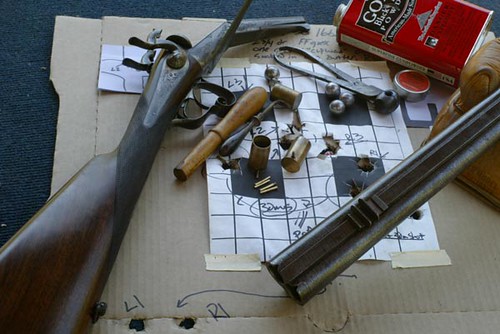| tinker |
| (.416 member) |
| 18/12/06 02:01 PM |

|
|
|
I'm confident your rifle was regulated at the factory.
My bore rifles also have their barrels touching at the muzzles.
Don't underestimate the sophistication of the design and build of that rifle.
Looking at those chambers, I wouldn't jump to assume that the right chamber has been 'ringed' as the black powder cartridge shooting scene would say.
The first assumption I'd come to on that visible feature is that someone at some time (for a long time) left a paper hull in there and the chamber rusted then pitted a bit at the mouth of the hull.
You should look in there with a very critical eye and some good lighting -- stuff some white patches in those bores to act as reflectors -- and look for signs of those chambers having been 'cleaned up' at some time in the past. I would have telescoping gages in there immediately.
Cast them too, with Cerrosafe alloy (you can get it from Midway or Brownells) and get casts of those bores while you're at it.
I'd be suprised if they haven't been cleaned up a bit.
They might even be longer than they were when the rifle was brand new.
Consider a couple things about overall length.
First off, different hull designs and different base wad designs will yield different powder capacities.
Pack your hulls with black powder and keep adding powder till it shoots together.
You will need over powder cards, I make mine in the shape of a cup, with the open end facing the powder. I make them from milk carton material.
You will need felt wadding and black powder lube. There are many different recipes for home made black powder lube, and there are commercially available products like Bore Butter (which I use, it's great) too.
You'll likely need to experiment a bit with how much wadding and how much black powder lube you'll need to do the job, also with how much you'll need in order to fill the case with powder, wadding, and roundball.
Seat the roundball at the mouth of the case.
Some guys use melted bee's wax to seal the roundball at the mouth of the case. I haven't needed to, but I haven't taken my cartridges into foul weather either. I haven't needed to crimp or fold or roll the case mouth to hold the roundball.
If you're using plastic, just set yourself up with a sizing die to reduce the diameter of the hull shell so the roundball will push in with a good friction fit.
Really, it's easy.
Get some hulls, make some over powder cards or cups and make some felt wads. Grab your powder and some groove diameter roundball and shoot the thing with something less than it should shoot with, then keep shooing it, adding powder till it shoots it's barrels together.
You will almost definitely need more volume of modern black powder than the powder it was designed for way back when. Today's powders just don't make nearly as much energy as black powder from the 1870's
Set your cartridges up with an overall length short enough to allow the chambered rounds to have at least a little bit of jump. You don't want the roundball touching the rifling with chambered rounds in a closed action.
--Tinker